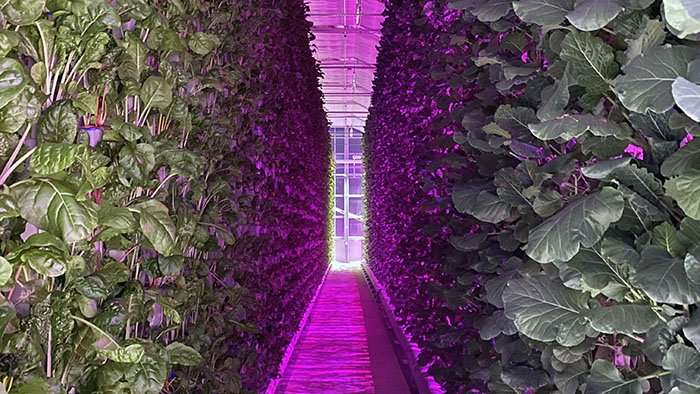Hydroponic Oregano: A Comprehensive Guide to Sustainable Herb Cultivation
The difference between fresh herbs and the dried ones you buy in glass bottles at your local grocery store cannot be overstated. Those looking for fresh, flavorful oregano prize the ability to grow this herb indoors all year long. One way to manage this is through a hydroponic growing system.
Oregano is just one of many plants that grow exceptionally well in a hydroponic system. Below, we’ll explore oregano in hydroponics and how to produce the best hydroponic oregano.
Hydroponic Produce Series:
Hydroponic System Types for Oregano
Hydroponic systems suspend seeds above nutrient-rich water rather than planting them in soil. There are numerous hydroponic systems to choose from, but below we'll focus on a few that are particularly suitable for oregano cultivation.
Nutrient Film Technique (NFT)
Prominent among the available options is the Nutrient Film Technique (NFT). In this system, plants thrive with their roots directly exposed to a constant flow of water. This arrangement mimics the natural habitat of plants growing on the edge of a river bank, where soil erosion has left their roots dipping directly into the water.
NFT hydroponics is an effective method for growing oregano, though it does necessitate diligent monitoring. Maintaining oxygen and pH levels is crucial to ensure your plants' optimal growth.
Deep Water Culture (DWC)
Deep Water Culture (DWC) is a hydroponic system that is relatively easy to establish. Here, growers suspend their crops above a water reservoir with their roots fully immersed. Nutrient solutions are added to the water to give the plants the essentials for growth. The water must be oxygenated to prevent root rot, typically using an air pump and air stones. Given its simplicity, this system is ideal for beginners.
Aeroponics
In aeroponics, plants grow with their roots exposed to air. These roots are periodically misted with a nutrient solution via an automated system. This system minimizes the risk of root rot as roots have ample access to oxygen between misting cycles. However, it requires careful oversight as any malfunction in the misting system can lead to crop failure, making it less suitable for beginners.
To learn more about aeroponics, see our article on the differences between Aeroponics and Hydroponics.
Drip systems
Sometimes referred to as trickle or micro-irrigation systems, drip systems were initially designed to irrigate soil-planted crops in arid climates like Israel. Instead of spraying or running water, this method involves slow drips or trickles, conserving water and ensuring plenty of air for the plant roots. Exercise caution to prevent mineral buildup in the drip heads, which could hinder water flow.
Ebb and Flow (Flood and Drain)
One of the more popular and user-friendly hydroponic systems is the ebb and flow, or flood and drain system. In this system, plants are grown above a tray or reservoir that is periodically filled and drained of nutrient-rich water. A potential drawback of this system is the possibility of high humidity levels near the base of your plants, which may cause leaf diseases. Regular checking for excess moisture under the leaves is recommended.
Wick systems
Finally, hydroponic wick systems are a low-energy hydroponic setup. In this system, plants are again planted with their roots dangling in the air above a tank of water. A soft fabric or string wick is then attached from the roots and dangling into the water. This wick naturally pulls water and nutrients up and onto the exposed roots, feeding the plants without the need for a pump of any sort.
Over time, the water may become low in oxygen, so an air pump and air stone (similar to that used in deep water culture) is advisable. Growers must also flush out the wick system with clean, fresh water about once a week to prevent the buildup of minerals.
For more information, we wrote a whole guide to understanding the difference between Hydroponics, Aquaponics, and Aquaculture.
Preparing for Hydroponic Oregano Cultivation
Choosing the right variety of oregano
There are several varieties of oregano available, and each has its own flavor profile. The most common are Greek oregano and Italian oregano, but other varieties you may like include golden oregano, Syrian oregano, and sweet marjoram. All of these varieties can grow successfully in the hydroponic system of your choice, so this is primarily a matter of personal taste and how you plan to use your plants. If you’re unsure, consider planting several varieties so you can sample each.
Gathering necessary equipment and supplies
Next, it’s time to gather any supplies you will need to grow your oregano plants. Before getting started, purchase all of the components you will need for your chosen hydroponic system. Be sure to include the nutrients, grow lights, and cleaning supplies you will use to keep your system running smoothly.
Preparing the growing environment
Once you’ve constructed your system, you’ll also need to consider the environment around it. You will likely need to heat and cool the climate around your plants and ensure that they are getting plenty of sunlight.
Growing Hydroponic Oregano: Step-by-Step
Below we will offer the basic steps for growing oregano in a hydroponic system. Please be aware that much of this will depend heavily on the system type you chose to grow your hydroponic oregano, so you may need to adjust accordingly.
Planting seeds or cuttings
Oregano seeds grow best at temperatures around 70°F. Most growers prefer to begin germinating seeds by placing them on a wet paper towel, where they will get plenty of light. In general, your oregano seeds will take about 3-5 days to germinate.
Another option for growing hydroponic oregano is by starting with a cutting from a healthy oregano plant. If you choose this option, cut about 5-6 inches from a mature plant, then remove the lower leaves. Place the bottom of this stem in your chosen growing medium, ensuring access to water and nutrients. You may choose to coat the end with a rooting hormone, but this isn’t necessary.
Transplanting oregano into the hydroponic system
If you started your seeds or cuttings outside of your hydroponic system, you need to know how to transition them into it. If you started your plants in soil, you need to ensure the roots are clean before transplanting the plant into your hydroponic system. Gently dip the roots into clean water and massage any dirt off the roots.
When placing the plant into your growing medium, ensure all of the roots have access to the water and nutrient solution and spread them apart to prevent clumping. Dim your grow lights for a few hours to help the plant transition.
Daily maintenance and care
While growing your hydroponic oregano, you’ll need to care for it on a daily basis. Check temperatures, pH levels, and aeration. Regularly clean all components of your system to ensure no mineral buildup disrupts your growing process.
Nutrient Requirements for Hydroponic Oregano
Oregano is a fairly easy plant to grow. It’s hardy and very forgiving for first-time hydroponic growers, so it’s an ideal beginning plant.
Essential macronutrients and micronutrients
The three essential nutrients in most hydroponic solutions are nitrogen, phosphorus, and potassium, referred to as NPK. For oregano plants, you want your NPK ratio to be 111-62-66.
Appropriate pH and EC levels
Keep your hydroponic solution’s pH level in the 6.0-8.0 range for hydroponic oregano. pH levels will likely drop toward the end of the growing period, so be sure to monitor and adjust them as needed.
You’ll also need to monitor electrical conductivity, or EC, levels. Hydroponic oregano does best with an EC level in the 1.5-2.0 range.
Nutrient solution temperature
Finally, carefully control the temperature of the nutrient solution in your system. Keep it in the range of 55-70°F for optimal growth.
Lighting for Hydroponic Oregano
Natural vs. artificial light
Natural sunlight is generally the best option for all plants, but it may not be reasonably available for your indoor hydroponic system. Fortunately, artificial light can still provide everything your plants need for proper photosynthesis. Oregano plants can easily thrive indoors with artificial lighting when your grow light system is designed properly.
Selecting the right grow lights
Plenty of light is necessary for oregano and other herbs to produce the natural oils that give them their flavor. Look for full-spectrum LED lights that offer plenty of light intensity without creating much heat. You’ll also need to keep these lights on for most of the day, so carefully choose a lighting option that uses minimal electricity and has a long service life.
Determining optimal light duration and intensity
In general, oregano needs a lot of bright light to thrive. It’s best to set your grow lights to be on 12 hours a day and roughly six inches above the top of your oregano plants. Note that lighting systems that put off a lot of heat will need to be adjusted to keep from overheating your plants.
Temperature and Humidity Control for Hydroponic Oregano
Ideal temperature and humidity levels
As mentioned above, oregano grows best at temperatures around 70°F. It can still thrive in temps between 50°F and 80°F. Oregano plants like a fairly humid environment, so consider using humidifiers around your plants if the air in your grow room or greenhouse is too dry.
Climate control equipment and strategies
There are two primary methods to control the temperature and humidity around your plants. You can do this manually with heaters, air conditioners, humidifiers, and dehumidifiers, but this requires a great deal of trial and error. The other option is to purchase a hydroponic climate control system, though this may be too expensive if your budget is tight. Either way, be sure to carefully consider the climate around your plants, as this could make or break any crop.
Harvesting and Storing Hydroponic Oregano
When and how to harvest oregano
Oregano is a hardy plant and can be harvested again and again without the need for replanting. These herbs taste best when harvested just before they flower, as that is when flavorful oils are at their highest concentration.
Once your oregano plant is about 4-5 inches tall, use a sharp pair of scissors or gardening shears to cut the stem just above the bottom pair of leaves. The plant will then regrow itself from this level and form new stems that can be harvested again as they grow tall enough.
Drying and storing oregano for long-lasting flavor
Like most herbs, oregano will have the strongest flavor when used soon after harvest. If you will be using your fresh herbs within a few days, place your oregano in a plastic bag with a lightly damp paper towel, then store it in the fridge. To keep your oregano for later use, you can dry it by hanging bundles of stems upside down in the sunlight. You can also freeze the herbs to maintain their flavor.
Troubleshooting Common Hydroponic Oregano Issues
Nutrient deficiencies and imbalances
If you notice yellowing leaves on your oregano plant, it’s likely not getting enough nutrients. Adjust your nutrient solution to offer more nutrients to your plants.
Pests, diseases, and environmental problems
Common pests include aphids and spider mites. If you detect an infestation, treat it as soon as possible with neem oil or insecticidal soap to prevent the problem from spreading to other plants.
The most common disease that may impact your oregano is a fungus called botrytis rot. If you notice rotting leaves in the center of the plant, remove the affected plant and destroy it immediately to prevent spores from spreading to your entire system.
Gradual wilting of the entire plant may be a symptom of root rot. In this case, your plants’ roots are likely not getting enough oxygen. In this case, you will likely see brown or black discoloration on the roots of the plant. Adjust your hydroponic system to allow for more aeration in the water or longer root drying periods.






